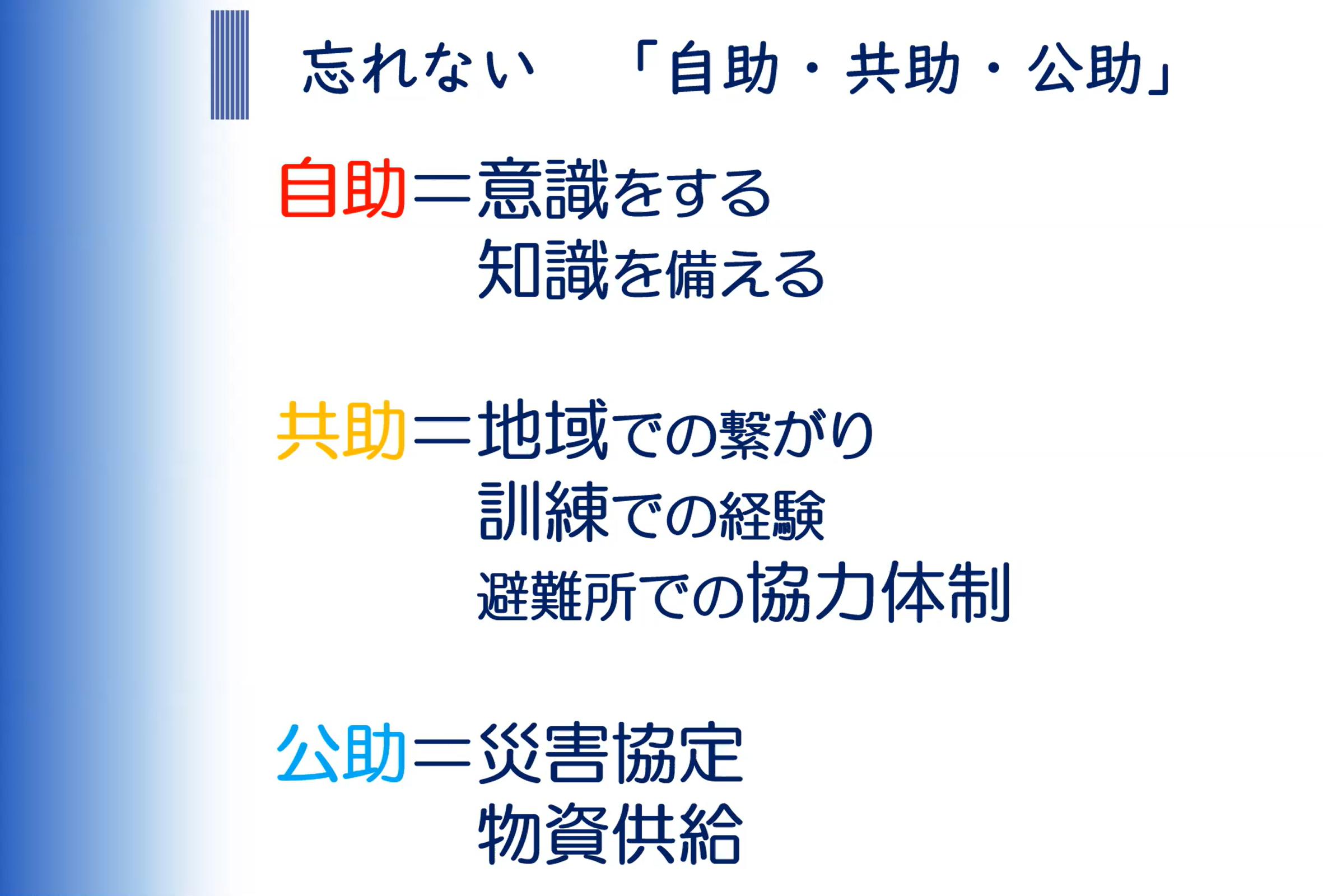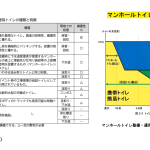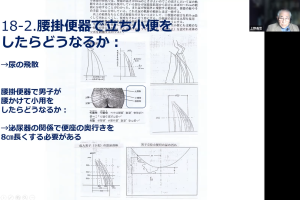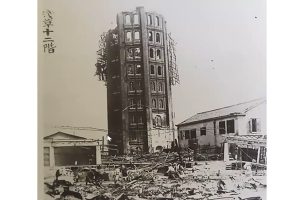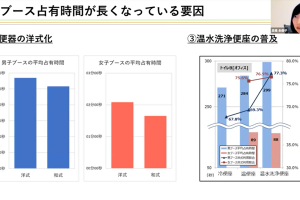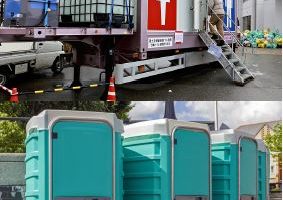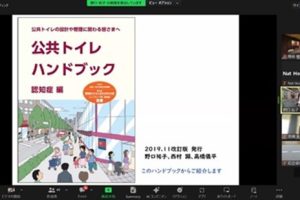The 20th seminar
“What will happen to the toilets at a disaster?” -1
– “Evolving Toilets” book series, volume 1 “Disasters and Toilets” edited by Japan Toilet Association
Japan Toilet Association (JTA) Seminar Series; “Let us know more about our Toilet Story”
Date: 12 January 2023 (Thu) 18:00-20:00 JST
Presenters:
Mr. Kohei Yamamoto (JTA steering committee member, Dynax Urban Environmental Research Institute Co., Ltd. Chairperson)
Mr. Wataru Tanimoto (JTA steering committee member, General Manager, Sales Planning Department, Hino Kogyo Co., Ltd.)
Organizer:
Yoshihiko Kawauchi, Ph.D., JTA steering committee member, Former professor of Toyo University.
Terminology:
Each of the four types of toilets (Handy, Portable, Temporary and Manhole) described in this paper provides the following features.
– Handy toilet
It is a handy use toilet that is compactly packaged for use. It can be carried in a bag or pocket of the clothes. and used in the vehicle while a traffic jam or by setting it in a toilet bowl without the flush water at the incident of a disaster. Many handy toilet products are ingratiated about the storage methods and hygiene matters.


– Portable Toilet
A toilet bowl made of a plastic or cardboard which is quite light and easy to carry to install at a disaster. It can also be placed by the bedside of people who are difficult to walk to reach the toilet cubicle in the house. It is possible to place even in a small space. Many portable toilet products are ingratiated about the storage methods and hygiene matters.

– Temporary Toilet
This is a temporary use toilet in a cubicle made of a metal, reinforced plastic, etc., and there is a sump under the toilet bowl. It is often used at a building construction sites, event venues, and the evacuation shelters at a disaster.

– Manhole Toilet
It is a toilet mainly used at a disaster. The manhole cover lid of the sewage system is opened, and then a toilet bowl is placed over the hole covering with a tent for the blindfold.

References: https://www.mlit.go.jp/common/001180224.pdf, https://excelsior-inc.com/products/hotilet.html
(1) Part 1: Lessons learned from the past disasters and efforts by the national and local governments
[About the book volume 1, “Disasters and Toilets” among “Evolving Toilets” book series]
(Yamamoto) There is a Research Group on the Disasters and Temporary Toilets in JTA, and I am the chairperson. This research group played a main role in publishing a book titled “Disasters and Toilets” among “Evolving Toilets” series.
This series consists of three volumes, published one after another from July to September 2022.
There are many different situations when it comes to “disasters and toilets”, and there are various approaches for each one. I thought I would try to explain it in an easy-to-understand way. Members of our research group are daily working in their field and have created this book to provide readers with information from the actual field directly. The book consists of four chapters, and Chapter 1 describes the situation of toilets in past large disasters in Japan.
Chapter 2 does the counter plan for the disaster toilet measures by the national and local governments.
Chapter 3 does the distribution and rental systems of the temporary toilets. The temporary toilets are quite useful at the disaster, but the issue is that they cannot be procured immediately.
Chapter 4 does what kind of toilet methods shall prepare in advance at home for a disaster, and what must be done when a disaster occurs. It is written the things to be careful about in the toilets of the flats since about 80% of people live there nowadays in the city centre.
It took 91 days for the water supply recovery and 135 days for the sewerage to restore the lifelines. This system includes the sewage treatment plants. It is necessary to keep in mind that the lifelines related to water will take time long to restore after a disaster. The electricity was recovered relatively swiftly.
JTA organized a toilet-related volunteer group with about 200 people about a month after the disaster. They cleaned the toilets at the evacuation shelters and surveyed the actual conditions of the toilets. The temporary toilets were delivered well by one month passed after the disaster, but the actual situation was dire. There were only the squat style toilets at the school where the residents evacuated. Then, it was necessary to install the pedestal style portable toilet particularly for the elderly people. The water supply was still cut off, so they used the pool water for the flush toilet. There were some places where it could not be used for toilets since the water there had to be reserved mainly for the fire extinguishment. They were forced to use the water from a nearby river eventually. There was even a place where the flower bed in a school was dug up and turned into the toilets.
The importance of toilets has become highly recognized after catastrophic Hanshin-Awaji Earthquake disaster. The Japanese government created a guideline for securing toilets based on this sour experience. In a way, I felt the toilets may be more important than the food. Many elderly people dared prohibiting eating because they hated to go to the toilet after it. The toilets were very important factor for maintaining health during the evacuation. However, it was insufficient consideration for the elderly, disabled, women and children. The pedestal style toilets were already common at home, but most of the school toilets and the temporary toilets were the squat style one which was quite difficult to use for these users.
There are various types of temporary toilets, such as the collapsible toilets and box-shaped toilets, but there are hiding own problems. Even if there were temporary sump toilet sets, many places were prohibited to use because the shortage of the lorries for the septic to come and clean the filth. There is usually without lighting in the temporary toilets. There found an unexpected problem that the silhouette of the tent-type temporary toilet can be seen from the outside when lighting inside at night. In addition, the temporary toilet is high positioned above the ground since the toilet is placed on the filth tank. It was hard work for the elderly people to climb the stairs to reach there. Also, we had to consider various problems such as the distance from the shelter and the location where it shall not be a blind spot since the temporary toilet will be installed outdoors.
The temporary toilets had not made much progress even after catastrophic East Japan Earthquake in 2011 which was happened 16 years after the catastrophic Hanshin-Awaji Earthquake. The sewer pipes were not broken so much in places where was no liquefaction occurred at catastrophic Hanshin-Awaji Earthquake. Whereas, it occurred in reclaimed land such as Urayasu City at catastrophic East Japan Earthquake Disaster, and the total sewer systems were damaged there, then the toilets were unusable for long period eventually. There was a severe shortage of toilets in Kobe at the first period of the evacuation. However, the complaints decreased after the temporary toilets were installed at a rate of one in every 100 evacuees in two weeks after the disaster.
Finally, about one temporary toilet was installed for every 70 evacuees and the complains reduced. This figure is referred as a standard since then. There is an international standard for humanitarian assistance called SPHERE Standard. A guideline by Cabinet Office for preparing and managing toilets based on this SPHERE standard. It is required one toilet for every 50 people, and one for every 20 persons in long term evacuation period.
[Reflectional points in Kobe City at catastrophic Hanshin-Awaji Earthquake] A toilet is an essential of our life. A centralized toilet coordinator and command centre must be necessary particularly at a big disaster. The management of the temporary toilets did not clearly establish in Kobe City. The work of collecting the excrement did not go well as it was not clear their locations and numbers. It was quite big problem for the government that cleaning the temporary sump toilets that are no longer in use now and preparing a place to store them after the evacuees are back to their normal lives.Various support goods supplied from all over Japan and the world, but some of them were not what we really needed. I thought it was necessary to establish the logistics to procure the shortened items. The handy toilets are now recognized as a formal product, although they were not so common at the time. Afterwards, it was quite difficult to dispose the garbage bags that were used as the temporary defecated.
Furthermore, there was insufficient support for people who had difficulty in using the toilet. Another problem is the toilets for the volunteers use. The disaster volunteers must be self-reliant in principle, but even though they cannot help using the toilet. However, it happened that the disaster volunteers were not allowed to use toilets in the disaster area. This is another serious problem.
[The perspectives on the diversity] Ms. Sachiko Asano wrote from the perspective of the gender diversity in this book. It was pointed out that the evacuation toilets are impossible to feel at ease or restless for the diverse genders, and there were still beyond the comfort.There is an evacuation centre check sheet “A Guidelines from the Perspective of Gender Equality at Disaster” issued by the Cabinet Office. There are listed the check items; The toilets shall be installed in safe and easy to reach places. Men’s and women’s toilets shall separate locations. The outdoor toilets shall be lighting at night in the toilet cubicles and routes to toilets. The toilet plan for the diversity will not be enough to make a simple distinction between the disabled and the elderly. It is necessary to give careful consideration according to the types and degrees of the disability and the methods of assistance.
In addition, Mr. Asano says that it is necessary to ensure that diverse people will participate from the stage of beginning of a toilet plan to involve the entire local community. Ms. Sadako Sasaki of the DPI Disabled Women’s Network writes that it is necessary for the women with disabilities to provide the support by the assistance women based on her own experience.
The accessible facility is essential. It is necessary to set up the information desks, supply distribution centres, and make toilets easier to understand by with a large sign board and colour-coded tape for the visual impairments. The disaster prevention and evacuation manual for the visually impaired was issued by the Japan Federation of the Visually Impaired. It points out the difficulties to move to and use the toilet for the visually impaired to find out in the gymnasiums or other large spaces. In addition, it points out the necessity to consider well that the people receiving assistance by the helpers are recommended to stay their homes, but their helpers could not visit to the home at the disaster in case.
[National and local government systems] A push-type support is institutionalized in National Disaster Prevention Basic Plan. The national government provides support without a request from the local government when a large disaster occurs. This plan was activated for the first time at catastrophic Kumamoto earthquake in 2016. The disaster filth management plan by Ministry of the Environment stipulates that a pumping method for the temporary sump toilets must be prepared. “Guidelines for Securement and Management of Toilets at Evacuation Centres” issued by the Cabinet Office lists the matters to be prepared about the safety, the hygiene and comfort, women/children, the elderly/people with disabilities, foreigners, and others as considerations for the toilets at a disaster. Install the pedestal style toilets for the elderly and people with disabilities in the convenient locations, keep flow lines to toilets, eliminate steps in toilets in the evacuation spaces, etc. It is also mentioned that it is necessary to prepare a toilet that can also be used by the caregivers.However, it is impossible for a single evacuation centre to handle exclusively. There is a system called welfare evacuation shelters, where especially for those who need assistance can easily use or evacuate. “SPHERE standard” requires at least one toilet for every 250 people that is designed to be accessible for a wide range of people. Use the handy toilets or portable toilets immediately after a disaster, and then use the temporary toilets after well delivered. Alternatively, it is necessary to prepare something like a manhole type toilet at the evacuation centre to prepare the situation that the toilet cannot be used. There is still some uncertainty as to whether the local governments have established plans for the toilets in advance.
About a half of the municipalities replied to have a disaster toilet plan in their local disaster prevention, according to our survey conducted in 2019, but there are still doubts about the completeness. Another problem is that 34% of the municipalities replied they had no plans for it.
About 74% of the municipalities replied they stockpiled handy toilets. The manhole type toilets are gradually progressing.
The temporary sump toilets need to be pumped up, but this is not sufficient. Only a quarter of local governments have agreements with the private contractors, and more than half still do nothing. The number of household sump toilets for collecting filth is rapidly decreasing, and the number of lorries for the septic to pomp up is also proportionately decreasing, which is quite a big problem at the disaster. The development of the accessible toilets in the schools and evacuation centres is still halfway through.
There are about 12,000 manhole style toilets in Tokyo according to the Tokyo Metropolitan Government’s regional disaster prevention plan. There are about 1,000 of a sort of the temporary toilets. There are 47,000 portable toilets in total. However, it is quite inadequate for 10 million inhabitants in Tokyo. In fact, this numbers varies from district to district. Edogawa Ward’s emergency toilet plan aims to prepare one toilet for every 75 people.
This book introduces to be considered when they calculate the necessary number of toilets, the expected number of evacuees, the target number of toilets to prepare, the number of toilets in demand, the number of toilets to be used immediately after the disaster, and the number of shortages. It also proposes the factors to be considered the number of the temporary toilets to prepare, and how many handy toilets and portable toilets shall be stockpiled against the disaster. New types of the temporary toilets, which are quite different from those used at conventional sites, are beginning to be produced. They are just like a container that is once used on a ship to be remodeled into a toilet, a towing type toilet pulled by a car, and a vehicle-mounted type. Some local governments are preparing new type of the temporary toilets with the enough size and the toilet bowl are like a general comfortable toilet.
[A proposal of a dedicated toilet section in a government] I have been proposing the establishment of a dedicated toilet section within the municipality because the toilet issue is seriously important.The management of the facilities and public toilets by the local governments is sectionally divided, and the field of toilet administration that manages at the entire toilet environment in a cross-cutting manner. It is not possible to provide detailed support at the disaster since there are almost no staff with specialized knowledge or experience regarding the toilets.
The idea is to set up a dedicated section that controls comprehensively over the toilets during normal times and acts as a control tower for the toilet matters at the disaster. During normal times, this department specializing in toilets does many things such as the development and maintenance of the public facilities and toilets, establishing a disaster toilet plan for preparing the manhole toilets, improving the existing toilets, building cooperative relationships with the private business, and preparing disaster prevention drills for toilets, and so on.
(2) Part 2 Temporary toilets
The temporary toilets cannot be immediately delivered: to the spot because of the transport problems.
(Tanimoto) I am the deputy chief of the Research Group for the Disaster and Temporary Toilet in JTA. I work in Hino Kogyo company, a manufacturer of the temporary toilets in Japan, which mainly sells and rents the temporary toilets. The company supplied them for almost all large-scale disasters since catastrophic Hanshin-Awaji earthquake in 1995. I have been involved in all large-scale disasters in Japan after catastrophic Kumamoto earthquake in 2016.
It is said that it takes at least three days for the temporary toilets to be delivered the affected areas after a big disaster occurred. It is not always three days but more. For example, the temporary toilets were delivered to some evacuation centres on the same day or the next day after catastrophic Kumamoto earthquake. This case was fortunate that the affected area was relatively limited, and a temporary toilet rental company nearby was not seriously damaged, and the roads were not seriously blocked. However, it took more than three days according to my memory for the temporary toilets provided by the Cabinet Office and the Ministry of Economy, Trade, and Industry.
Our company delivered nearly 500 temporary toilets, but it took about a month to deliver totally. It will be trouble with the toilets in the long term at a large-scale disaster, although it eventually depends on the scale. The reason why it takes at least three days is that roads were cut off, the social conditions were in turmoil, and information about road conditions was not enough available to the temporary toilet manufacturers and the rental companies. Furthermore, there was a problem of the fuel shortage, and it was difficult for the private lorries to drive in the area at the time of catastrophic East Japan Earthquake.
The Ministry of Economy, Trade and Industry requested shipment of the pedestal style temporary toilets soon after catastrophic Kumamoto earthquake. Prior to that, basically all the temporary toilets shipped were squat ones. The principle changed to the pedestal style toilets at the request of the government after catastrophic Kumamoto earthquake. Basically, the most efficient way to transport a temporary toilet is to disassemble it into parts. 10-ton size lorry can only load 20 assembled toilets. When the parts can be disassembled, 40 of them can be loaded, which is double of the number, and we send a lot more quickly. On the other hand, it is necessary to assemble it on the site by the experts. They are usually transported by the lorries since carried by the air is expensive. They were transported by Self-Defense Force transport planes at catastrophic Kumamoto earthquakes. The socially vulnerable people will feel that they hate to go to the toilet when the number of toilets is insufficient, or people do not want to use, or difficult to use by the toilet situation. Then, some people will not eat or drink to hate to go to the toilet eventually.
The economy-class syndrome is a disease where the blood clots are formed due to lack of water while a person remains in a cramped posture. There were many people stayed in their cars at catastrophic Kumamoto earthquakes, because they were worried that their houses may collapse. There were many people suffered from this syndrome and some died. Because of this, it was necessary to deliver the toilet as soon as possible, therefore we cooperated with Self-Defense Forces and airlifted them. The issues of air transportation is the limited space and the cost of the aircraft. It requires to report the details before departure, and this is costly and time-consuming.
The toilets that have delivered are once collected at a site and then delivered to evacuation centres in many separated places. The water and food can be carried by hand or by bicycle. However, it is very difficult to manually unload and move temporary toilets from the lorries. It is hard for the unexperienced to do from the lorries of the Self-Defense Forces with a high loading platform. The most difficult ipart for the installing temporary toilets is the transportation.
[The temporary toilets cannot be delivered immediately from the limited dispatch locations] Another problem is the dispatch locations are quite limited. There are only a few companies that produce the temporary toilets, and their locations are limited. The transportation often takes long distances to the disasters occurred location, and what is more there is a problem of the shortage of long-distance drivers. There are only about 5 major temporary toilet manufacturers in Japan. There are in Shizuoka, Okayama, and the Chubu area.The temporary toilets are basically rental ones even at the disaster. There are rental companies in various places, but their inventory will be limited, and the toilets are often shipped directly from the manufacturer’s factory at the large-scale disaster. It will be delivered on the same day within 100 km distance, otherwise it will take two days over 500 km. [The limitation of the lorries] A third reason is that the types of lorries that can carry the temporary toilets are limited.
The temporary toilets are used to be transported by “Flatbed body lorries” without the roofs. There is also a lorry called “Box body lorries”, where the loading platform is covered with walls and a roof with shaping like a box.
The box body lorry keeps the luggage from getting wet by the rain and good for drivers. There are the box body lorries about 40% of the total lorries these days in Japan. The luggage is loaded and unloaded by hand and often get wet in the rain at the flatbed body lorries. It is declining year by year, and now the ratio is only 20%. A flatted body lorry is suitable for the transporting the temporary toilets, but it is becoming difficult to reserve this type lorries. In addition, there is the year 2024 problem. The regulations from 2024 is that lorries can transport in one day will be shortened in the distance, and this may have a serious impact on the transportation at the disaster. [The pedestal toilet for the temporary ones] As Mr. Yamamoto mentioned before, the temporary toilets do not make much progress between catastrophic Hanshin-Awaji Earthquake in 1995 and catastrophic East Japan Earthquake in 2011. The temporary toilets are mainly used at the construction sites nowadays. It is firstly required to be low price, and the cheaper squat style ones are the majority. Also, the construction sites are male-dominated place and many workers dislike the pedestal style toilet for the seats to touch with the skin. As a result, most of the temporary toilets provided by the rental companies are squat style ones. Therefore, the squat style toilets are the first to be shipped to the disaster area eventually. However, the coverage of the pedestal style toilets in private houses is 89.6% now, and 100% of newly built houses install the pedestal style toilets on a little old data though.
The government has led to provide the pedestal toilets at the construction sites since 2016. They call them “Comfortable toilets.” The Ministry of Land, Infrastructure, Transport and Tourism (MLIT) established 17 items in the specifications, and among them 11 are essential items. Firstly it must be the pedestal style. Secondly there are lighting equipment without connecting wires. The installation numbers of “Comfortable toilets” are gradually increasing. The most recent construction sites by the direct control by MLIT and the public civil engineering sites have reached 45.6% of the coverage. However, the public works in the overall construction cover insufficiently. Comparing 2010 and 2020, the percentage of the pedestal style toilets including the sump ones kept by the toilet rental companies increased from 7% in 2010 to 28.9% in 2020.
The production rate of the pedestal toilets has also increased from 16.8% in 2010 to about 40% in 2020. The government efforts must be heading to the favourable direction. These detailed materials are available on the website of the Japan Toilet Association about Research Group for Disaster and Temporary Toilets. The numbers of universal toilets, accessible multipurpose toilets, container toilets, and toilet cars are gradually increasing along with the number “Comfortable toilets.”
The rental companies keep the accessible toilets only about 0.1% out of the temporary toilets which they store. There is almost no request for the accessible toilets at the construction sites. It is more realistic to prepare the accessible toilets in such as schools rather than the rental companies. These toilets can be used as evacuation centres for even when the infrastructure is cut off.
[Things to do when the temporary toilet delivered at an evacuation centre] The first step is to decide the location to install it, when the temporary toilet delivered to the evacuation centre. It is often the case that the installation location has not yet been decided, before it is delivered to the centre. Once installed, it is hard to move to the different location, so it is necessary to carefully consider the installation location in advance. As for the location of installation, there is a desire to locate it in a nearby and bright place from the point of the crime prevention. On the other hand, some people complain that they smell bad when placed near to their stay. These two requirements are contradictory and difficult to resolve.It will be better to involve women at the deployment plan. Women can often look at the issues differently rather than men. It must be careful to place it where the lorries for the septic can enter and reach for collecting filth. There are many cases about the handover of the temporary toilets is not done well,as the person in charge at the local government office changes frequently. The cleaning and maintenance methods for the temporary toilets are quite different from the residential or public ones.
It is necessary to create a manual in advance to perform the cleaning referring to it. The National Building Maintenance Association has created a useful manual called “Evacuation Sanitation Manual.” The temporary toilets gradually tend to be getting dirty and uncomfortable when used for long time. The odor prevention and insect repellent measures are necessary. Many manufacturers have recently released deodorant and insect repellents for the temporary toilets.
We believe that it is important that a private company concludes agreements with local governments and provides information on the site to the national government under this disaster agreement although some local governments do nothing after signing the agreement. It is necessary for the central government to control dominantly, especially in large-scale disasters. We cannot fully expect the priority to that party even if they conclude the agreement with the local government. The main thing is to prepare for the disasters in advance through the disaster prevention drills and seminars in the district, and proceed the communication networks.
It is commonly said there are “Self-Support”, “Mutual-Support”, and “Public-Support.” This ratio is commonly said to be 7:2:1. The “Self-Support” must be generally the highest ratio. However, almost all people believe that the ratio of “Self-Support” is the lowest and “Public-Support” is the highest. Things won’t go well without preparing by oneself, and purely expecting support by the national and local governments.
What is “Self-Support” with the temporary toilets? The temporary toilets are not stockpiled in the general households. However, we must be conscious that the temporary toilets and toilet problems against the time of a disaster as well as being informed are important. The keeping connection in the area is important on “Mutual-Support.” We cooperate with all people in local and care about the temporary toilet, and sometimes we train to use it. The disaster agreements are concluded in terms of “Public-Support”, and the preparations are made for provision of the temporary toilets and supplies. Please don’t forget to be aware of the disasters, and in case of a disaster, cooperate with everyone to overcome it.
(3) Part 3, Q&A
[Q1: HO] Who is the intended main readers for this book?
[A1: Yamamoto] At first, the publisher requested to publish it understandable even for the junior high school students. It’s not always common case, but the book aimed at a wide range of the readers. There is a case that the children in after-school daycare are referring to this book about toilets with the disaster prevention.
{Q2: HO} What kind of situations can be assumed for using ICT to use toilets in times of disaster?
{A2-1: Yamamoto} I think it would be useful to have a system applying ICT to inform the location and status of toilets. It is important to know the location of the toilet, particularly for the volunteers. They are permitted to use quite limited ones, and in this case, it would be beneficial if information could be obtained by the smartphone app. Also, the locations of evacuation centres and the number of evacuees fluctuate when the time passes. I think it would be more effective if we could grasp the exact situation and manage maintenance using such an app including the evacuation support.
{A2-2: Tanimoto} For example, at a large event such as a musical concert, the temporary toilets are installed around in several locations. QR code is printed on the handouts distributed to visitors. This is a system where visitor can find the information such as where the toilet is available by the smartphone. However, it might be occupied when the user reach there, even if it informed empty. Another usage is the utilization of ICT in management. It must be useful if the toilet administrator receives an email notifying that the water is running low or the filth is full, then the cleaners will fix it promptly.
It is possible to predict how soon the toilet tank will be full, but it’s still not in practice. One reason is the cost issue. The rental fees for the temporary toilets are very cheap, so it cannot afford to cover the cost of the communication. The sewage tank contains not only the urine but also the excrements and toilet papers. As a result, the edges of the tank may not be filled even though the centre level mis-recognizes full with the false information. When the total amount is not full status, the efficiency of the lorries for the septic will be less effective. This phenomenon happened in both catastrophic Hanshin-Awaji Earthquake and catastrophic Kumamoto Earthquake. Consequently, ICT applied to the temporary toilets is not rapidly progressing.
[Q3: HO] Can the disaster toilet method be applied even in war place like Ukraine?[A3: Yamamoto] I don’t know whether it can be in the same way as a disaster toilet in a battlefield. But SPHERE standard is exactly the toilet standard for people displaced by the conflict. The handy toilet might be useful even at the battlefield. [Q4: OS] The temporary housing, companies that are members of industry groups such as the Japan Prefabricated Construction Suppliers and Manufacturers Association have inventories for the temporary housing. Will a similar system work for the temporary toilets?
[A4: Tanimoto] By my knowledge, the member companies of the Association do not have stocks for the disasters, and the association itself does not keep stocks. There is a little leeway in the quantities that each of them reserves for the sale and rental. In case of the emergency, these can be collected and provided. I think it’s basically the same way as the temporary toilet industries like ours.
The government inquiries us several times a year, how much the inventory we have now and how many can we produce at the emergency?
We try to keep extra inventories for the emergencies and keep them in safer places. Soon after catastrophic Kumamoto earthquakes, our company delivered nearly 500 temporary toilets, but they were assembled new ones from the stock.
[A5-1: Yamamoto] I think this is probably the first model. It was said that it could not be towed by a usual car and that the price was too expensive at the first one. Then it has been improved to be a bit compact and has been purchased by some local governments. It is reassuring to see a major company making a high quality, towable temporary toilet as a business even thorough a part of their social contribution.
These towable temporary toilets should not be used only for the disaster, but also for everyday use. If these toilets were placed in the parks or towns like the toilets in Paris, the town shall be more active. Then at a disaster they can be pulled by a car and used. It is also conceivable to use it daily on various places by having it owned by the local governments or the area management organizations.
[A5-2: Tanimoto] The latest model; Toyota mobile toilet version 3 becomes more realistic as it can be towed by a regular car with an ordinally driver’s license. For instance, the container-type trailer toilets and the next-generation circulating bio-toilets are equipped with the solar panels and are completely self-supporting. This is an excellent in shape that can be used without any infrastructure. As Mr. Yamamoto said earlier, it is important that the national and local governments purchase those qualified toilets and daily use them. Then they can switch to use of its mobility at the sudden emergency.Ideally, large-scale bio-toilets shall be installed in the public facilities and used them at an emergency. However, the development will not proceed immediately due to the limited financial resources. I think it would be good to gradually improve the quality of the conventional temporary toilets and replace some of them with high-quality ones. It is important that companies such as Toyota, which had nothing to do with toilets in the past begins to deal with the toilets and the disaster issues.
[A5-3: Yamamoto] There is a general incorporated association called “Mutual Aid Japan.” They are working to encourage the local governments to have one tow-type toilet and carry out activities to help each other for the disaster. In the past, there were quite few rental toilets in the municipalities. The large cities kept the toilets called the mobile toilets for their events. There is a gradual movement to reconsider such things. However, it is difficult to make all temporary toilets with high quality immediately. I think it must be a nice idea to use them daily preparing for the case of the disaster. [Q6: Kawauchi] I heard that the number of the lorries for the septic is decreasing since the flush toilets become more common. In that respect, I think that pumping up must be a bottleneck for the temporary toilets near future.[A6: Tanimoto:] The lorries for the septic fee in Tokyo is too expensive compared to the rural areas since they come from far away places.
However, the flush toilet will not be supposed as a substitute. At construction sites and event sites, there is no flush toilets because there must be not enough infrastructure and the construction period is limited. Therefore, I think that the lorries for the septic cannot disappear inevitably. [Q7: Kawauchi] The requirements for the lorries for the septic suddenly increases in case of a wide area disaster. At that time, I am worried whether being able to handle them properly.
[A7: Tanimoto] The local governments started collaborating with nearby sump companies in advance since it is a problem for the lorries for the septic must come from far away.
Mr. Kohei Yamamoto Mr. Wataru Tanimoto
